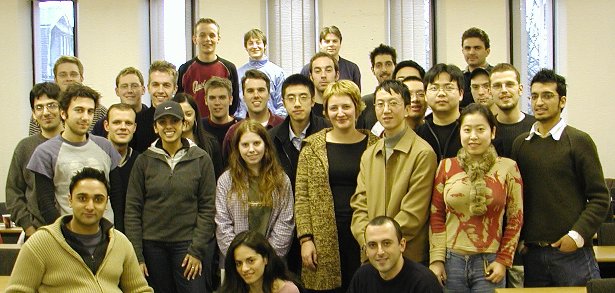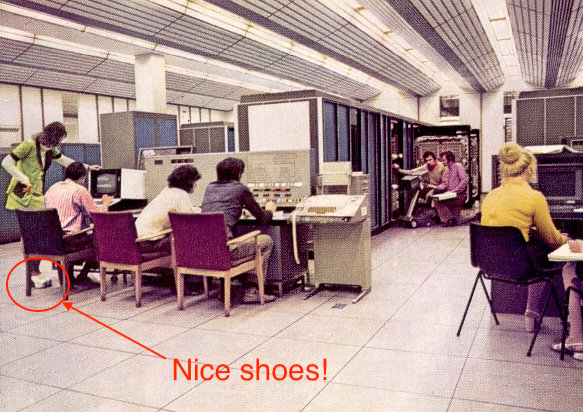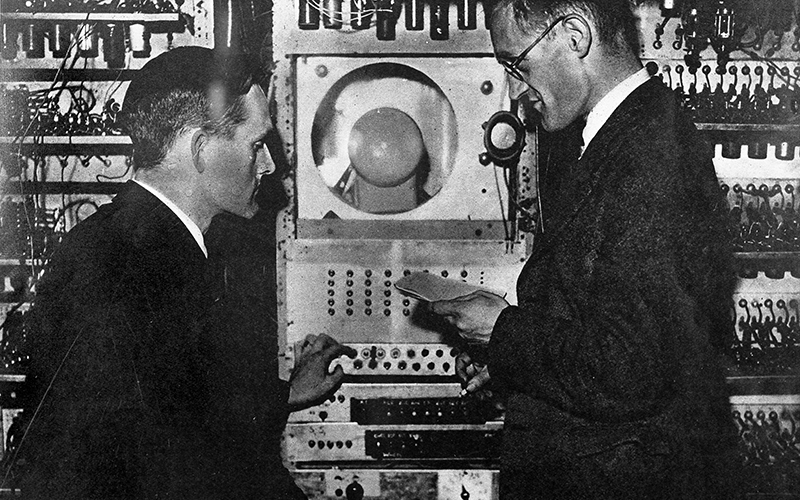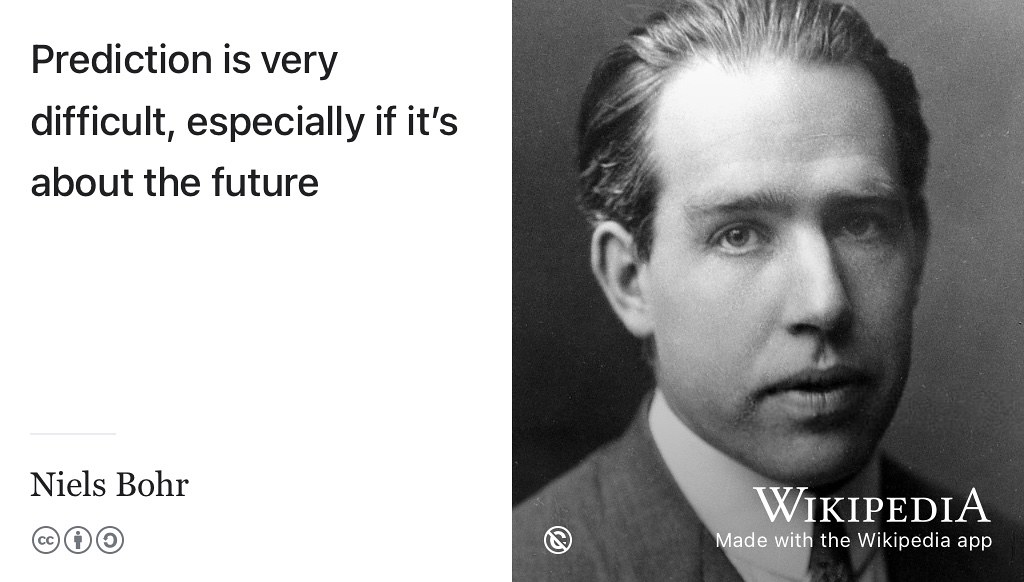A Computing the Future
One hundred years of computing from 1948 to 2048, stopping at the classes of 2003 and 1978, with some pictures, dad jokes and geek history.
A.1 The Class of 2003
Let’s start our computational odyssey in 2003, figure A.1 shows students of the MSc Computer Science class of 2003. That’s me in the back row standing highest on the left hand side. We are smiling because we were being entertained and educated by Richard Giordano, who took this picture while teaching. We are proud members of a community of more than 10,000 students have graduated with a degree2 in Computer Science since the University was the first in the UK to provide an undergraduate Computer Science degree course in 1965. (Brackenbury 2005)

Figure A.1: The class of 2003 including Matthew Horridge, Michael Parkin, Karim Nashar, Iain Hart and myself in the back row
Twenty five years earlier, before many of the people in the above picture were born, there was the class of 1978…
A.2 The Class of 1978
Figure A.2 shows Manchester staff operating the MU5 computer sometime around 1978. Most people will have little interest in the hardware that the people in the picture are using. However, a wider audience may be interested in the suave and sophisticated seventies Saturday Night Fever dancing shoes that Pat McKissack on the left of the picture is wearing. (Gibb, Gibb, and Gibb 1977)

Figure A.2: “You know Simon once we’ve debugged this code, we’re going straight down the discotheque to dance the night away to that groovy new hit record by those local Manchester lads the Bee Gees. How does it go? Night fever, night fever, we know how to show it.” The people in the picture are, from left to right, Pat McKissack (wearer of fantastic shoes), Simon Lavington, Gordon Frank, Roland Ibbett, Peter Whitehead, Tony Whitehouse and Lynne Plant (seated at the system performance monitor). The MU5 console is in the foreground with the big machine in the background. The picture is probably taken sometime between about 1972 and 1978, but we’ve gone for 1978 so that we can make gratuitous references to seventies disco music. See the original unadulterated image via Simon Lavington and the Computer Conservation Society. (Lavington 2008)
Now, Java junkie James Gosling has fond memories of using a whopping 8K of memory from around about the same period. (Gosling 2004) But if the class of 1948 (see section A.3) were alive today and had seen the Four Yorkshiremen sketch (Brooke-Taylor et al. 1967) they’d probably say:
Memory? Memory! LUXURY….’Ere in Manchester, when we were lads and built computers, we didn’t even have any memory. We had to make our own from an old bit o’ tube we found lying around in t’lab. ‘Course it only stored 2048 bits and worked for a few hours. Ohhhh we used to DREAM of havin’ 8K of memory….
They may have had to use very primitive memory, but at least Tom and Freddie didn’t have to build their computers out of mechanical discs and wheels, or even better Meccano. (Hartree and Porter 1935; Darwin 1958) Moving on swiftly, we go back a little further in time, thirty years earlier…
A.3 The Class of 1948
Our next stop is in 1948. We have to stop here because the Manchester Baby first ran on 21st June 1948. Figure A.3 shows Tom and Freddie with the Baby. (Lavington 1998)

Figure A.3: Freddie Williams and his PhD student Tom Kilburn programming the Manchester baby in 1948.
Armed with some double-sided sticky-tape, several empty fairy-liquid bottles, lots of patience and an idea from some bloke called Alan Turing, Tom and Freddie built the world’s first stored-program computer. The stored-program was significant as it was the predecessor to what we now call random-access memory (RAM), see figure A.4. (Webb 2013)
Figure A.4: This video was produced by Google as a tribute to the Manchester Baby — the first computer to run a program electronically stored in its memory. You can also watch the full 7 minute video embedded in this figure at youtu.be/cozcXiSSkwE (Lavington et al. 2013)
Does this mean the Manchester Baby is the world’s first computer? Well, it depends on your definition of computation: It is surprisingly hard to define what counts as a computer and who built the first one (Malcolm 2000).
Whatever your definition, after Tom and Freddie, things were never the same again. The rest, as they say, is history. That computer you are using…
- laptop, desktop
- tablet, phone, satnav
- car, a computer with wheels
- plane, a computer with wings
- games console, wearable tech etc
- smart card, embedded system etc
- Smart motorway or transport system
- household appliances, washing machine, doorbell etc
… is a direct descendant of the rather strange looking machine in figure A.3. In 2023, the BBC published archive footage of Tom Kilburn being interviewed by Brian Redhead in 1981 about the big machine and its successors, shown in figure A.5.
Figure A.5: Broadcaster Brian Redhead interviews proud Yorkshireman and Manchester United fan Tom Kilburn in 1981. You can also watch this 14 minute video at youtu.be/CQ2EBw7AgZY (Redhead 1981) This clip looks very dated now (male, pale and stale) but provides an interesting window on the past. It was acceptable in the 80s, it was acceptable at the time. (Harris 2007)
You don’t need to be a Manchester United supporter or from Yorkshire, like Kilburn was, to appreciate computing. A little basic arithmetic helps illustrate how far we’ve come since 1948 and 1981.
A.3.1 Numbers Speak Louder Than Words
What’s interesting about the difference between 1948 and now are the changes in the efficiency, size and speed of computers, shown in table A.1. It’s hard to describe in words the difference between 1948 and now, in this case, the numbers speak much louder than words ever could:
| Baby in 1948 | ARM in 2000 | |
|---|---|---|
| Size | Filled a medium sized room | fills 7mm by 3mm of silicon |
| Power usage (Watts) | 3.5kW (3500W) | 215mW (0.215W) |
| Instructions executed (per second) | 700 | 100,000,000 |
| Energy efficiency (Joules per instruction) | 5 | 0.000 000 002 (that’s 2,000,000,000 times more efficient than The Baby!) |
So where is all this going? What about the future? Let’s take a longer view, and skip forward from 1948 to 2048…
A.4 The Class of 2048?
Our next stop is 2048. For the number nerds out there, this year is pleasingly 100 years after 1948 so a sensible place to make our next stop. 2048 is also 100000000000 in binary (211) and the maximum number of bits (not bytes) that the Manchester Baby stored in its Cathode Ray Tube (CRT) memory. A whopping 2048 bits, or 256 bytes, with 8 bit bytes! (Kilburn 1948)
What will classes in the year 2048 be studying? Well, in the year 2048, Computer Science won’t exist anymore either because:
- As Richard Feynman said Computer Science is not actually a Science (Feynman 2000)
- As Hal Abelson said the significance of computer science “has little to do with computers” (Abelson, Sussman, and Sussman 1996)
- As Paul Graham said There is no such thing as “Computer Science” (Graham 2003, 2004)
- As George Johnson said All Science Is Computer Science (Johnson 2001)
- As Bill Gates said Computation is Transforming the Sciences (Gates 2005)
Either way, what is known as Computer Science today will have become so fundamental to many other areas of research, the discipline will naturally become more closely integrated with them. Take Manchester as an example, the hard-sums people will join the mathematics department, the architecture geeks and hardware nerds will join the engineering department, the Computational Biologists will go and join Life Sciences or Medicine, and so on. Of course, I could be very wrong here! As Niels Bohr in figure A.6 might have once said:

Figure A.6: “Prediction is very difficult, especially if it’s about the future”. Often attributed to Physicist Niels Bohr, it is disputed if he actually said this, see wikiquote.org/wiki/Niels_Bohr#Disputed. Public domain image of Niels Bohr by the Nobel foundation on Wikimedia Commons w.wiki/3dqV
Prediction is very difficult, especially if it’s about the future. Which is a good point to close this essay on.3